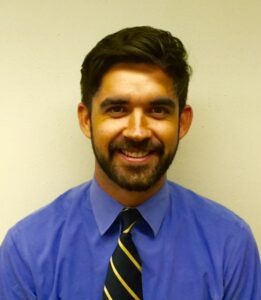By Garrett Thompson
“The Young and the RIC-less: Musings from a Millennial Audiologist” is a new quarterly column by Garrett Thompson.

Garrett Thompson
How can we use empathy to improve the UX of the patient, and why are young audiologists the perfect group to champion this change? From smartphone apps to Gmail to the iPhone itself, young AuDs grew up with products that were specifically designed with intuitive UX in mind; we see it as a given that products are easy to use. When is the last time you had to read the instruction manual of the app you just downloaded? (Trick question: it doesn’t have one, because it doesn’t need one.)
Watching a toddler effortlessly use an iPad is seeing good UX in motion. Intricately analyzing the consumer experience, their wants and needs, and evolving one’s offerings to meet those needs is critical in this process1. Audiologists must do that now, especially with the younger generation of Baby Boomers who will use our products and services in drastically different ways.
I am amazed, for example, by what we expect of our patients who are still in the workforce. In my life, with an 8am-4pm externship schedule, it is very inconvenient to go to even one doctor’s appointment. But to fit hearing aids on the much-heralded, working-age, mild-to-moderate hearing loss patient, she has to take time off for (on average) three appointments over the span of six weeks?
We need to be empathetic in how we design this experience and consider it from the working-age patient’s perspective. We should analyze her interaction with this system, and personalize the treatment plan based on her needs and wants. We know personalization increases consumer satisfaction2; it also shows compassion.
Compassion is at the core of patient-centered care, and being cognizant of the value of someone’s time is paramount. I believe the reason Costco is the fastest growing segment of the hearing aid market is simple: it’s less expensive and it’s open seven days a week. People like convenience. This is consistent with a trend across healthcare, as we see an increasing popularity of decentralized, accessible options such as urgent care centers, pharmacy “minute clinics”, and telemedicine apps3.
Private practice audiology can heed this trend and improve convenience by offering after-work or weekend hours. We should also embrace telehealth and remote programming as a means for follow-up services when physical alteration of the devices is not required. Given the efficiency of telehealth, you could see several working-age patients during their lunch break, without them ever leaving the office!
By customizing a treatment plan with these services, patients will recognize your compassion and superior UX; and it will break down a major barrier for working-age Boomers with hearing difficulties.
Breaking Down Barriers to Hearing Care
We need to systematically examine the process with which a person moves from initial onset of hearing difficulty to acquisition of any amplification device, and finally to hearing aid use (or non-acquisition).
- What steps do they take in doing personal research, either online or through word of mouth?
- What medical professionals do they interface with before we see them?
- Which forces encourage them to seek intervention; which serve as roadblocks?
- What does the average Baby Boomer think of audiologists, do they know what we do?
- What sources are they listening to, who do they trust?
The best way to find the answers to these questions is straight from the source, by asking our patients. Getting involved with community events or HLAA advocacy groups provides invaluable information. For example, at my alma mater (City University of New York) students recently held a collaborative event with the local HLAA chapter.
In the words of the CUNY SAA president Kathleen Wallace, “Patients so clearly know what they want, and what they would like from audiologists. It was really productive to hear directly from so many patients and advocates all in one room.”
When asked what priorities were articulated she said, “They wish audiologists counseled more on T-coil and looping, as well as strategies for self-management of hearing loss like aural rehabilitation. Another focus was how audiologists can attend to the emotional component of living with hearing loss, and when to refer when we cannot.”
Understanding how patients experience hearing loss, what they want from audiologists, and what information they consume before we ever see them is crucial. In my experience, patients are quite influenced by Consumer Reports, online hearing aid forums, and the opinion of their PCP or ENT. We should focus on getting our message to these influencers, as they are often responsible for changing social behavior on a large scale4. Most importantly, we need to stay positive in these tumultuous times.
We need to reflect on our process and self-improve. We need to replace this statement:
“Face it, people don’t want hearing aids.”
With this:
“How many ways can we improve the User Experience of hearing aids so people love them?”
References
-
- Christensen, Clayton. The innovator’s dilemma: when new technologies cause great firms to fail. Harvard Business Review Press, 2013.
- Shankar, Venkatesh, Amy K. Smith, and Arvind Rangaswamy. “Customer satisfaction and loyalty in online and offline environments.” International journal of research in marketing 20.2 (2003): 153-175.
- Yee, Tracy, et al. “The surge in urgent care centers: emergency department alternative or costly convenience.” Center for Studying Health System Change. Washington, DC (2013).
- Gladwell, Malcolm. The tipping point: How little things can make a big difference. Little, Brown, 2006.
Garrett Thompson is an audiology student at the City University of New York and is currently completing his externship at the Callier Center of UT-Dallas. He was a national finalist in the 2015 Academy of Doctors of Audiology student business plan competition. His writing has previously been featured in Audiology Today and Audiology Practices. Thompson received a BA in Economics from Boston College. Contact him at [email protected] or @Dr_Audball
Featured image courtesy ec4ublog






